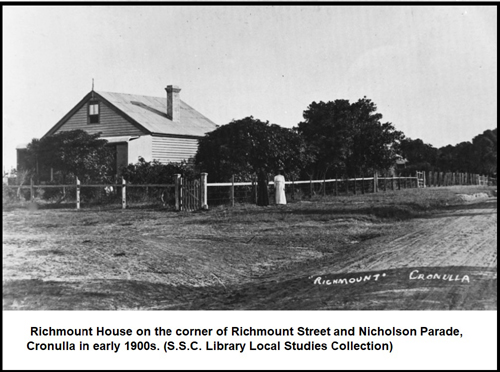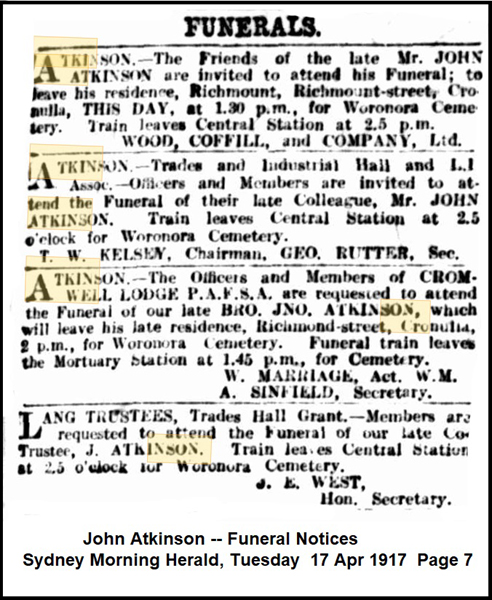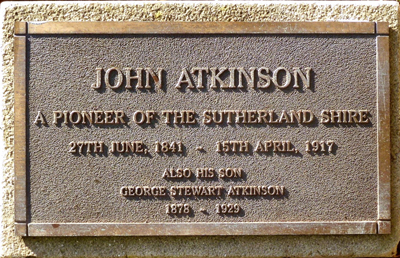

| Welcome | Database | Indexes | Copyright/Disclaimer | Login |
John ATKINSON, 1841-1917
John Atkinson was born on 27 June 1841 at Richmount (also known as
Richmond), in County Armagh, Ireland. He was the son of
Thomas Atkinson and his wife
Elizabeth, nee Taggart (1809-1885). Elizabeth was born on 3 July 1809 the
daughter of Andrew Taggart and his wife Margaret nee Russell. She was baptised
on 10 September 1809 at St Nicholas’ Church of England, Liverpool, Lancashire.
On 22 June, 1856, John
Atkinson aged 14, with his mother Elizabeth, a widow aged 42, and his sister
Margaret aged 18, arrived in Moreton Bay on the ship ‘Persia’. The family moved
to Balmain in NSW where John worked as a carpenter and shipwright. In 1860
John’s sister
Margaret Atkinson married
John Roper and in 1864 his mother Elizabeth Atkinson married Robert Linton.
Robert Linton died in Port Jackson in 1875 and Elizabeth Linton died on 14
September 1885. She was buried at Balmain Cemetery in Leichhardt,
now
known as Pioneers Memorial Park.
In the 1865 Sands Directory John Atkinson was described
as a shipwright, living in Paul Street, Balmain. In 1870, he married
Mary Falconer Stewart who was born in Dundee, Scotland in 1845, the daughter
of George Stewart and his wife Joanna Falconer nee Grieve. Mary Stewart arrived
in Sydney in August 1854 on board ‘Bride of the Sea’ with her parents and
siblings Alexander, George and Johanna.
After their marriage, John and Mary Atkinson lived in
‘Amaranth’ Mullens Street, Balmain and had five children:
Thomas William (1871-1934);
Joanna Stewart (1872-1946);
Elizabeth Margaret (1874-1875);
Eva M (1875-1875);
George Stewart (1878-1929).
Mary Falconer Atkinson died 30 September 1886
(RN139)(Balmain) and was buried in Leichhardt Cemetery now known as the Pioneers
Memorial Park.
In 1886 John Atkinson married
Lydia Mary Moore (RN139)(Balmain), the daughter of William Moore and his
wife, Mary Ann nee Mayball. Lydia was born in Portsmouth, Hampshire and arrived
in Queensland on 4 March 1884 on board ‘Northern Monarch’ and then came to
Sydney.
John and Lydia had
six
children:
Erina Melita AKA Rene (1887-1944);
Moira Gurvena (Jurvena) AKA Myra (1891-1968);
Olive Iris (1891-1952);
John Moore (1898-1949); Unnamed male (1903-1903).
The Sutherland district, although popular for fishing
and hunting had very few permanent settlers long after many other areas of the
state were settled. The dedication of the National Park in 1879, the approval of
the railway from Sydney through Sutherland to the South Coast which opened in
1885 and several major land subdivisions during the 1890s would bring about
change. In 1895 the Crown released two parcels of land – an area of farming land
at Menai and 450 acres at Cronulla for residential development. John Atkinson,
then a successful business man and close to retirement, was interested.
On 11 September 1895, the auction of Crown Land in
Cronulla took place and John Atkinson purchased a two acre Nicholson Parade
allotment for 16 pound. Three other men –Wilshire, Windsor and Trevellyan made
purchases at the same time and used their names for their properties. Streets of
that name still exist in South Cronulla.
John Atkinson chose to name his property after the
townland where he was born in County Armagh. He built a 10 roomed house and
named it Richmount on the land at the corner of Nicholson Parade and Richmount
Street where guests, like member of State Parliament and Secretary for Public
Works E W O’Sullivan and Peter Dodds McCormick, composer of Advance Australia
Fair, would often stay.

Atkinson also procured eleven acres of leasehold land on
Cawarra Road Caringbah where he established a dairy. For many years after his
death, his daughter, Olive (Cartwright) and her family operated the business. In
the 1950s Parke Davis acquired this property.
John Atkinso became very active in local affairs. He
helped to establish and became President of the South Cronulla Progress
Association and formed a Committee which, in 1903, built the Cronulla School of
Arts. He was also among the founders of the Ratepayer’s Association formed to
promote Cronulla and its neighbourhood.
John was particularly active in pressuring State
government to preserve all the foreshores as reserves for the people for all
time. Through his efforts the Cronulla Esplanade, Darook Park and Gunnamatta Bay
Park were dedicated. His close friendship with E W O’Sullivan, dating from his
Balmain days, was particularly important and Ewos Parade winding through South
Cronulla is a reminder of that.
In 1906 the Shire of Sutherland was established as a
result of the extension of local government to most of the state. John Atkinson
was a member of the Provisional Council, from 9 June 1906 to 23 November 1906,
which was set up to prepare for the election of Councillors. Voting was
restricted to rate-payers only, the owner-occupiers of land and was decided by
‘first past the post’.
John Atkinson continued to be involved in local matters
and in 1910 was still President of the Ratepayer’s Association. In 1916 he wrote
to the Liverpool Council drawing attention to the need for a military road from
Liverpool to the National Park to transport troops and also as a means of
communication between Liverpool and Cronulla. This became the Heathcote Road.
John Atkinson died at his home ‘Richmount’ on 15 April
1917. He was buried at Woronora Cemetery. Officers and Members of the Trades and
Industrial Hall and L I Assoc. and Officers and Members of Cromwell Lodge P A F
S A were invited to attend.


NSW BDM
Ancestry
Sutherland Shire Library
Sutherland Shire Local History Library- Oral
Histories
Sutherland Shire Historical Society Journal
Australian Electoral Rolls
NSW Assisted Immigrant Passenger Lists 1828-1896